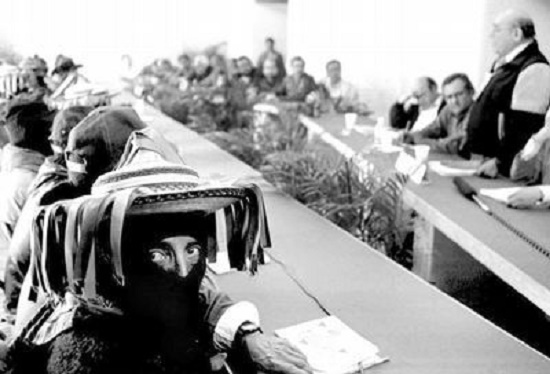
by Magdalena Gómez
To recount, as a backdrop: February 16th of 1996 in San Andrés Sakamch’en, Chiapas, a document that was called the Accords of San Andrés on Indigenous Rights and Culture, was signed by the delegation of the Mexican federal government as well as the Zapatista Army of National Liberation. Its contents expressed the commitment to push a constitutional reform that would recognize and guarantee indigenous rights.
The document was the result of the first roundtable, which in the end turned out to be the only one, and it was developed in the framework of the process established in the Law for Dialogue, Conciliation and Dignified Peace in Chiapas to address the causes that gave rise to the armed conflict initiated by the EZLN on January 1st, 1994.
Up to this point, the facts correspond with the designation of an agreement. However, since the moment of its signing, the official heading of the document contained the not-so-casual germ of what would give it the nature of a disagreement: Joint proposals that the federal government and the EZLN were commited to send to the national agencies of debate and decisión; thus, the governmental delegates left San Andrés with the conviction that the Congress would decide. On the other hand, we see that the significance of agreeing was dissociated between one side and the other. What did the peoples say? Now, yes we have given our word, now we have committed ourselves and this will be fulfilled. But it is not that they were confident either. We note two pieces of information: the EZLN refused to grant them the side-by-side photo of the signing, and told them that they would do it in a separate space; in addition, that day they released a commuiqué entitled Punto y Seguido in which they explained that it was just a start and that the road was long, complex and with differences to be settled in the following round tables.
It is important to highlight the unprecedented historical act of the EZLN to provide for the construction of its own agenda in inviting the indigneous peoples’ organizations of the country as advisors. It must be remembered that it was the indigenous commandancia that conducted the negotiation, without the presence of the then subcomandante Marcos, now sub Galeano. It was the first time in our history that the representatives of the Mexican State sat down face-to-face with the indigenous peoples and their demands. That Zapatista identification with the indigenous peoples of the whole country was expressed in the creation of the National Indigenous Congress (CNI) in October of 1996 and has been maintained since.
The second table on democracy and justice was openly sabotaged by the governmental delegation, which resulted in the decision of the EZLN to suspend the dialogue on September 4th, 1996, the situation that has been maintained since. Along the way, an attempt was made to renew talks on the part of the Zapatistas in 2001, with the then new government of Vincente Fox, setting conditions, among them the fulfillment of the aforementioned agreements through the approval of the proposed constitutional initiative, elaborated by Commission of Concord and Pacification. The EZLN carried out the March of the Color of the Earth across the country, which meant a virtual ratification on the part of the indigenous people. The indigenous comandancia and representatives of the CNI also went to the San Lazaro premises. There was no listening to the background and historical meaning of this whole process, and the Congress of the Union elaborated and approved its initiative, distorting and mutilating what was established in the 1996 agreements. The President of the Republic enacted it, and the EZLN reaffirmed the reasons for the suspension of the dialogue. The indigenous side promoted 330 constitutional controversies and the Supreme Court of Justice decreed the dismissal of the case. In addition, three complaints were filed before the International Labor Organization that were resolved en bloc in 2004 in which in general sided with the indigenous peoples and recommended to the Mexican State the revision of its counter-reform, something that never happened. Agencies of the United Nations have joined this position, but to no avail.
The EZLN withdrew to its territories to work on the construction of autonomous spaces, what we know today as Good Government Councils and the peoples in the rest of the country joined in this construction in practice, confronting the State that, in its neoliberal logic, approved an entire political and legal framework of dispossession, especially with the mining and energy reforms. The last occasion was in 2012 when the EZLN challenged the Peña Nieto government to fulfill the historical agreements, without even receiving a response. Today it is clear for the EZLN and the CNI that their struggle is for life and they have dedicated themselves to that with the realization of the Zapatista tour throughout Europe.
The current government recycled its low intensity neo-indigenism: individual subsidies, accompanied by large megaprojects, without reference on the President’s part, to the agreements of San Andrés Sakamch’en.
This article was published by La Jornada on February 15th 2022. https://www.jornada.com.mx/2022/02/15/opinion/015a2pol English translation by Schools for Chiapas, in solidarity.
